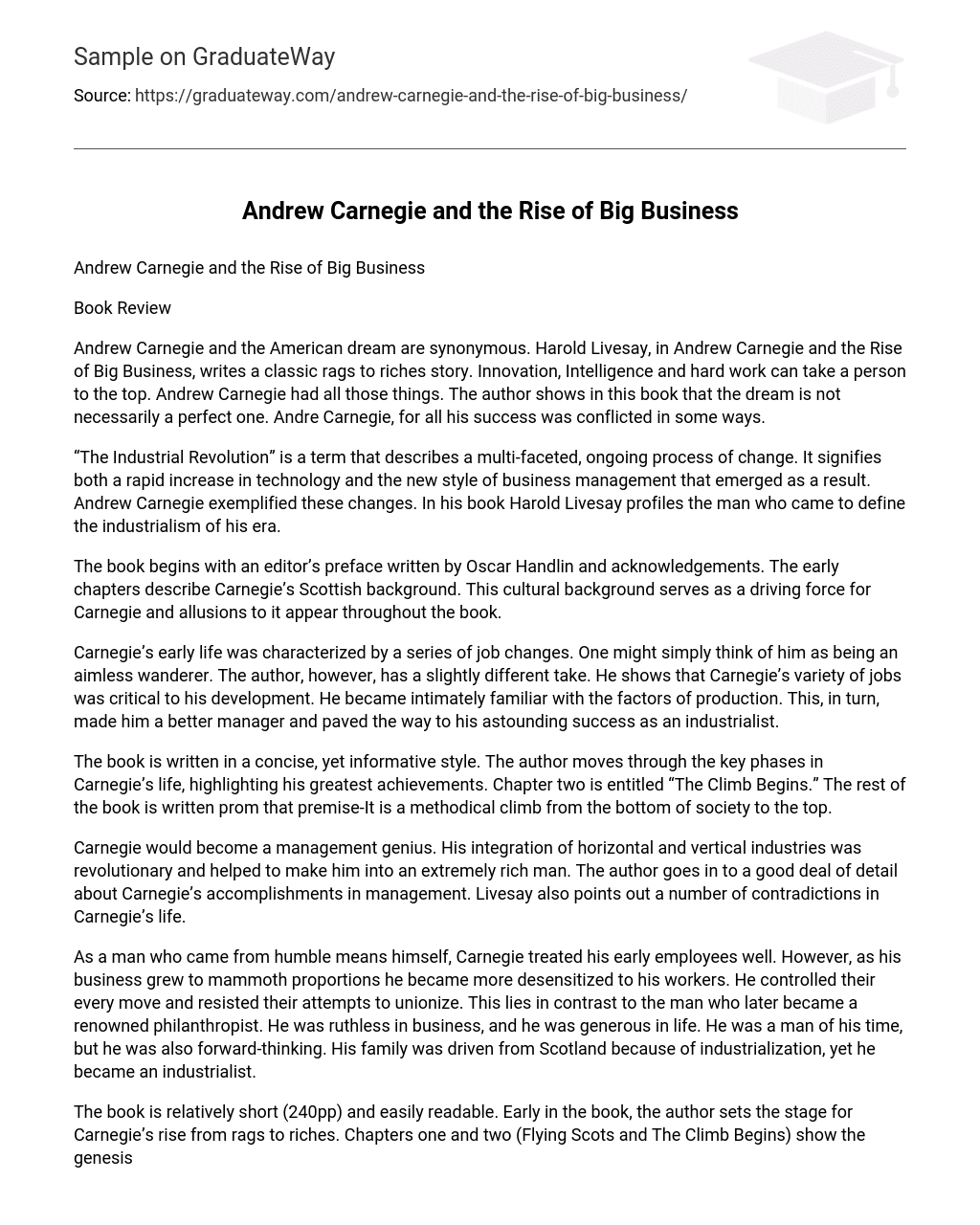Book Review
Andrew Carnegie and the American dream are synonymous. Harold Livesay, in Andrew Carnegie and the Rise of Big Business, writes a classic rags to riches story. Innovation, Intelligence and hard work can take a person to the top. Andrew Carnegie had all those things. The author shows in this book that the dream is not necessarily a perfect one. Andre Carnegie, for all his success was conflicted in some ways.
“The Industrial Revolution” is a term that describes a multi-faceted, ongoing process of change. It signifies both a rapid increase in technology and the new style of business management that emerged as a result. Andrew Carnegie exemplified these changes. In his book Harold Livesay profiles the man who came to define the industrialism of his era.
The book begins with an editor’s preface written by Oscar Handlin and acknowledgements. The early chapters describe Carnegie’s Scottish background. This cultural background serves as a driving force for Carnegie and allusions to it appear throughout the book.
Carnegie’s early life was characterized by a series of job changes. One might simply think of him as being an aimless wanderer. The author, however, has a slightly different take. He shows that Carnegie’s variety of jobs was critical to his development. He became intimately familiar with the factors of production. This, in turn, made him a better manager and paved the way to his astounding success as an industrialist.
The book is written in a concise, yet informative style. The author moves through the key phases in Carnegie’s life, highlighting his greatest achievements. Chapter two is entitled “The Climb Begins.” The rest of the book is written prom that premise-It is a methodical climb from the bottom of society to the top.
Carnegie would become a management genius. His integration of horizontal and vertical industries was revolutionary and helped to make him into an extremely rich man. The author goes in to a good deal of detail about Carnegie’s accomplishments in management. Livesay also points out a number of contradictions in Carnegie’s life.
As a man who came from humble means himself, Carnegie treated his early employees well. However, as his business grew to mammoth proportions he became more desensitized to his workers. He controlled their every move and resisted their attempts to unionize. This lies in contrast to the man who later became a renowned philanthropist. He was ruthless in business, and he was generous in life. He was a man of his time, but he was also forward-thinking. His family was driven from Scotland because of industrialization, yet he became an industrialist.
The book is relatively short (240pp) and easily readable. Early in the book, the author sets the stage for Carnegie’s rise from rags to riches. Chapters one and two (Flying Scots and The Climb Begins) show the genesis of Carnegie’s drive to succeed. The Carnegie’s were new immigrants to America who faced the same issues of assimilation as any other immigrants. The author shows that young Andrew’s mother was a driving force for him. He felt that he had to eclipse his father’s success. America is a place where respectability can be earned by hard work, and Carnegie was determined to do that. The author shows that Carnegie’s early jobs, ones most people would think of as “dead end”, were valuable learning experiences for Carnegie.
The middle of the book is devoted to illustrating Carnegie’s innovation in the business world. The chapters entitled The Master Moneyman, The Master Builder and The Master Manager describe in detail how Carnegie rose to the top of his field. These chapters contain a great deal of business detail, but they serve to put Carnegie’s work into the context of the larger industrial revolution. In the end, this is not a complete biography of Andrew Carnegie. It is, however, a historical record that puts the legacy of Andrew Carnegie into that context.
The later stages of the book stress Carnegie’s business legacy and philanthropy. More could have been written about his adult relationships. It would have been interesting to see how Carnegie’s conflicted nature played out in his personal relationships in more detail.
The early years of the Industrial Revolution brought tremendous change in business, the results of which changed all of our lives forever. The author shows Andrew Carnegie as a key figure in this revolution. The author convincingly points out that Carnegie and a few others of his generation are responsible for establishing the United States as the economic power it is today.
Carnegie was a man who achieved greatness, but he was not a man without flaws. At times, his overwhelming desire to succeed took a toll on the others around him. In the end he gave back much of what he had. Was this a sort of penance for the sometimes brutal tactics he had employed in the past? Was he guilty? These questions are left to the reader’s interpretation. Many people today would look at Carnegie’s tactics with the disapproval. Without condoning the harsher tactics Carnegie employed, the author effectively puts them into the context of the day.
References
Livesay, Harold. Andrew Carnegie and the Rise of Big Business (2nd Ed.). Boston: Little,
Brown, 1975.





